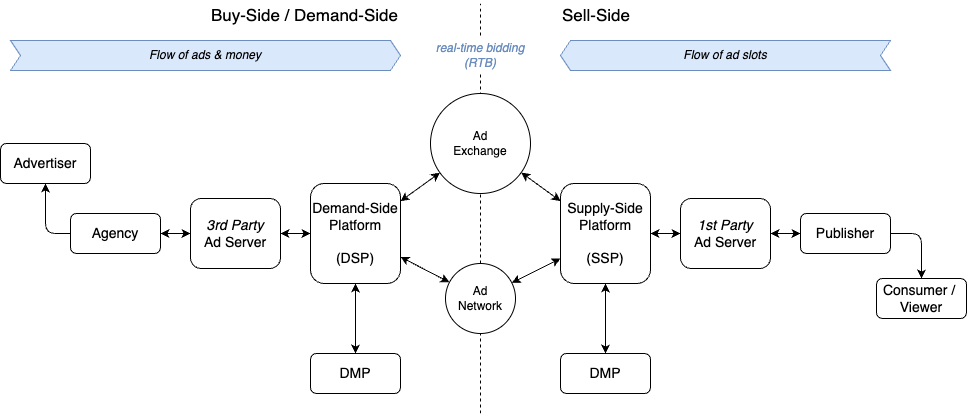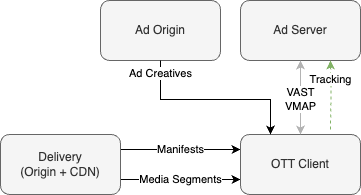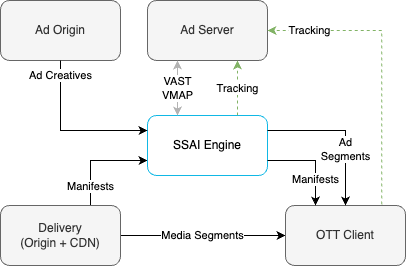Video advertising
How does one go about monetizing video content with ads?
The world of modern advertising is a highly complex one, packed with jargon and terminology and (already) a long history. This page won’t attempt to provide an exhaustive overview, but will concentrate on the concepts core to digital advertising and in particular programmatic advertising, which you are most likely to meet in your monetization efforts. We also only concentrate on aspects that are relevant to delivering video ads to viewers.
The online video advertising ecosystem is quite intricate, and the process that gets these ads to viewers is a complex one involving a finely woven interplay of multiple elements working together to create a seamless advertising experience.
At the heart of this process are the advertisements (or ad) themselves, which are typically inserted into streaming content during pre-roll, mid-roll, and post-roll stages (ie. before, in the middle of and after the content feature respectively). At a high level, an ad is defined by a creative (the actual content which needs to be shown to the viewers), with associated metadata that helps the components in the ecosystem handle the ad correctly, in terms of serving and tracking it.
From the moment an ad is created to the point it is viewed, it passes through a complex chain of systems and processes, each playing a crucial role in ensuring that the right viewer sees the right ad at the right time.
Programmatic Advertising
The traditional “Direct” advertising model (still used in some places) had a mostly manual process, with direct negotiations between advertisers and publishers to buy and sell ad space, and thereby determine what ads would be shown to what audiences. By contrast, Programmatic advertising refers to the automated process of buying and selling ad inventory, powered by software platforms, which offers many advantages such as higher efficiency, more precise targeting, real-time adjustments and rich data analytics capabilities.
Actors

Ads are stored and managed in ad servers, which are systems that co-ordinate the work of deciding which ads to show, to whom, and when. They take into consideration factors such as viewer behavior, ad requirements, and targeting parameters.
Connected to ad servers, we have demand-side platforms (DSPs) and supply-side platforms (SSPs). DSPs are the toolkits advertisers use to automate the purchase of ad inventory from multiple sources through one interface. This automation greatly increases the efficiency and reach of ad campaigns, allowing advertisers to target specific audiences and optimize their ad spend.
On the other side, SSPs help publishers, or those with ad inventory to sell (for example, streaming platforms or websites), to manage their ad spaces effectively. SSPs interface with multiple ad exchanges, which are essentially digital marketplaces where ad inventory is bought and sold in real-time. This connection expands the reach of ads and helps ensure that publishers maximize their potential ad revenue.
Key concepts
This trading of ad inventory hinges on the process of real-time bidding (RTB). In RTB, ad impressions are auctioned off in the time it takes a webpage to load or a video to buffer. The highest bidder gets their ad shown to the viewer. This process ensures that ad spaces are efficiently allocated and helps maximize revenue for publishers.
To increase the chances of viewer engagement and conversion, ad targeting is critical in programmatic advertising. It ensures that ads are shown to specific audiences based on various criteria like demographics, geographic location, and online behavior, thereby providing a personalised and relevant experience.
Just as important is ad tracking because it provides actionable data that advertisers can use to gauge campaign performance, optimize their strategies, understand their audiences, and ultimately, improve their ROI. Without ad tracking, advertisers would be flying blind, making it much harder to achieve their marketing objectives.
Techniques
Ad Serving
At a very high (and very simplified) level, the process that leads to a viewer seeing a video ad in their stream is as follows:
- An ad call is made to the Ad Server. How and when that call is made very much depends on the type of content (VOD vs Live) and the video delivery stack.
- The mechanism of the ad call is usually defined by an ad tag, often taking the shape of a URL.
- The tag may be enriched with contextual information that the ad server will use for targeting, such as metadata about the content being watched, the type of player, user data, etc. The term ad macro (or more correctly ad tag macro) is often used to refer to placeholders within the ad tag that get replaced with that data.
- The Ad Server and other elements in the ecosystem such as SSPs and DSPs communicate to select what ad to serve, using all the metadata available to them about the ad campaigns and the context of playback.
- The Ad Server returns an ad response that contains information about the ad, such as where to retrieve the ad creative, how to track it and how it can be interacted with.
This whole process which involves multiple steps takes place in just a few milliseconds.
Protocols
To make the serving of video ads uniform and standardized across different platforms, the Interactive Advertising Bureau (IAB) developed the Video Ad Serving Template (VAST) and Video Multiple Ad Playlist (VMAP) standards.
VAST facilitates communication with ad servers, ensuring that ads are properly served and that interaction data is reported back accurately. More details on that format is in The VAST protocol
VMAP, on the other hand, allows content owners to dictate where and how they want ads to be inserted into their content, usually for VOD. More on this format can be found in The VMAP protocol
Both VAST and VMAP involve making ad calls using HTTP, and receiving ad responses in a specific XML format.
Ad Insertion
An important part of the complex chain lies in how ads are inserted into the video stream.
Client-Side Ad Insertion (CSAI) was one of the first methods used to deliver ads in the online video landscape. In this model, it is the video player on a viewer's device that makes the ad call to the ad server at the appropriate time during content playback. It is then in charge of rendering the ad creative at the correct point in the timeline (as pre-roll, mid-roll or post-roll). CSAI has been used for a long time already, but suffers from challenges like potential buffering, which can disrupt the viewer experience, and an increased susceptibility to ad-blockers.

Server-Side Ad Insertion (SSAI), often referred to as Dynamic Ad Insertion (DAI) or ad stitching, offers an alternative approach. Here, ads are inserted directly into the content stream in the delivery chain. This process involves combining the video content and ads into a single stream before being sent to the user’s device. SSAI has the advantage of providing a smoother viewer experience, as transitions between content and ads are seamless, reducing the chance of buffering. Also, because the ad content is embedded within the main video stream, ads delivered via SSAI are harder for ad-blockers to detect and remove.
In online streaming, the use of ABR streaming formats enables SSAI due to the segmented nature of the stream delivery. Since the stream (or rather collection of streams) delivered are split into small segments, it is possible to insert ad segments amongst, or as replacement to content segments, if necessary almost in real-time (as would be required for live streams). To do this “just” requires manipulating the manifest (which is essentially a short text file) accordingly.

Tracking
Ad tracking collects data on ad performance, keeping tabs on metrics such as:
- impressions: the number of times users get delivered an ad
- interactions: the number of times users interact with an ad, such as clicking on it
Tracking is usually powered by providing tracking URLs (also known as tracking beacons) in the ad response, which will be pinged (ie. called) at appropriate times. It is usually the responsibility of the video player to ping those tracking URLs since that’s where the viewer interacts with the stream.
However with SSAI, it is also possible for some tracking to be done by the system in charge of doing the ad insertion. The latter will be referred as Server-Side Ad Tracking (SSAT), and by contrast player-based tracking is called Client-Side Ad Tracking (CSAT)
Updated 4 months ago
For more on how broadpeak.io allows you to monetize your content through advertising, and associated workflows
